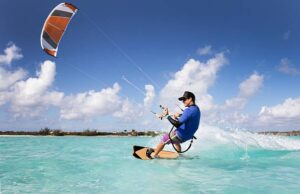Assault-Boardriding kite boarding requires a specific set of skills to get on the water safely. Beginners learn about the wind window and body dragging on land before they try it in the water.
They also practice avoiding back stalls and getting their feet in the board straps. The right conditions are also crucial, such as cross-shore and cross-onshore winds.
Equipment needed
Kiteboarding is an extreme sport that requires a lot of equipment. It can be done in water, land or snow and involves a kite flying above you, pulling you on a board. It would be best if you had a helmet and a harness to practice the sport safely. Other important gear include a kite, line knife and safety release system. It would be best if you also considered getting a wetsuit for cold weather locations.
 A helmet is a must for any kite boarder, as falling on water, land, or snow can result in serious head injuries. A hardshell helmet will provide the most protection for your head. They can cost $300-$400.
A helmet is a must for any kite boarder, as falling on water, land, or snow can result in serious head injuries. A hardshell helmet will provide the most protection for your head. They can cost $300-$400.
A safety release system is a crucial piece of equipment that connects to the kite control bar and the harness spreader bar. It has a red leash portion that you would activate in case of an emergency, releasing you from the kite and allowing you to exit the board. A safety release system will cost $40-$80. You should always check that the kite, lines and safety system are in working condition before going out on the water.
Safety gears
Assault-Boardriding kite boarding can be a dangerous sport and should only be undertaken with proper instruction. A helmet, impact vest, and personal flotation device (PFD) are essential safety gear. You should also invest in a harness and a kite leash. Additionally, it is a good idea to wear a wetsuit and sun protection.
The harness distributes the pull of the kite across your body and allows you to manoeuvre the kite without tiring out your arms. It comes in two primary forms: waist harnesses that wrap around your waist and seat harnesses that encircle your legs and hips. Waist harnesses are ideal for beginners.
The chicken loop quick release is a safety feature that can be activated if something goes wrong while you’re flying. Make sure it’s easy to activate, even under a strong load. It should also be able to “flag out” the kite, meaning it doesn’t generate any more power. Also, you’ll need a line cutter to cut the lines in case they get tangled. Most modern harnesses come with a slot under the spreader bar for line cutters.
Getting started
Before you get started kiteboarding, make sure you double-check your equipment. It includes ensuring that your kite, lines and control bar are in working order and show no signs of wear or tear. You should also bring a harness, helmet, wetsuit and buoyancy aid. You can also add water sport sunglasses, rash guards and GoJoes (safe board recovery aids).
Wind conditions are also important when learning kiteboarding. A smooth, steady wind is best, while gusty, turbulent winds with a large variance between gusts and lulls can be dangerous. They also make it difficult to select the proper kite size for a given wind speed.
Wind conditions
The most important thing to consider when choosing a spot to kiteboard is the wind conditions. Kites require a specific amount of wind to be launched and flown safely, so you should only head out in good wind conditions. Getting caught out on the water in bad weather can wreck your equipment and lead to serious injuries.
Kite boards are specially designed for the sport and come in a range of sizes to suit the rider’s ability level and the type of conditions they will be riding in. The harness, which is worn around the rider’s waist, distributes the pulling force across the body to reduce fatigue and improve control. The kite lines are connected to the bar on the rider’s control panel and come in various lengths for different conditions.
Equipment maintenance
Assault-Boardriding kite boarding is a high-tech sport that requires regular maintenance of the equipment to ensure safe rides. Several checks should be made on the kite, bar, harness, and board to keep them in good working condition. Rinsing the lines and bar in fresh water after every session is helpful in reducing salt buildup, which can damage the kite and reduce safety systems.
Checking the internal bladder for air leaks can be done by inflating the kite and looking for areas of weakness or small holes. These can be patched with kite repair patches, which are available at most kite shops.
A line length check is also important. Having equal line lengths helps ensure the kite flies properly and does not steer easier to one side.
Inspecting the board for chipped and dings is also important. These can be repaired with epoxy resin or superglue. A quick sanding before applying the resin is also helpful to remove any sharp edges that could cut skin. Also, storing your board vertically can help prevent it from warping over time.